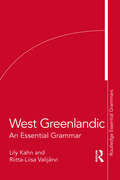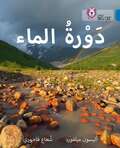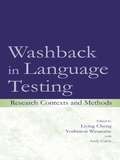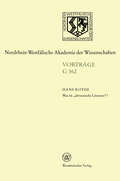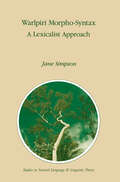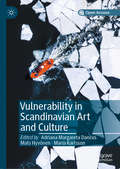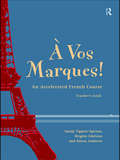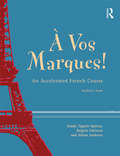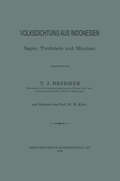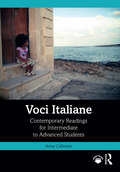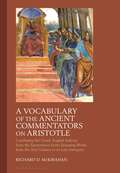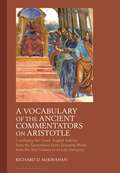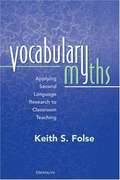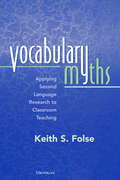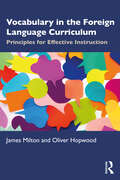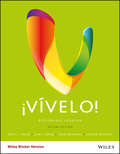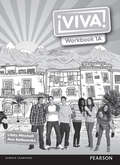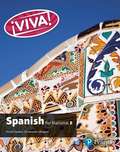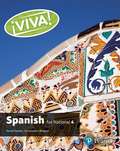- Table View
- List View
West Greenlandic: An Essential Grammar (Routledge Essential Grammars)
by Lily Kahn Riitta-Liisa ValijärviThis grammar provides a clear and comprehensive overview of contemporary West Greenlandic. It follows a systematic order of topics beginning with the alphabet and phonology, continuing with nominal and verbal morphology and syntax, and concluding with more advanced topics such as complex sentences and word formation. Grammatical points are illustrated with authentic examples reflecting current life in Greenland. Grammatical terminology is explained fully for the benefit of readers without a background in linguistics. Features include: Full grammatical breakdowns of all examples for ease of identifying individual components of complex words. A detailed contents list and index for easy access to information. An alphabetical list of the most commonly used West Greenlandic suffixes. A glossary of grammatical abbreviations used in the volume. The book is suitable for a wide range of users, including independent and classroom-based learners of West Greenlandic, as well as linguists and anyone with an interest in Greenland’s official language.
West Greenlandic: An Essential Grammar (Routledge Essential Grammars)
by Lily Kahn Riitta-Liisa ValijärviThis grammar provides a clear and comprehensive overview of contemporary West Greenlandic. It follows a systematic order of topics beginning with the alphabet and phonology, continuing with nominal and verbal morphology and syntax, and concluding with more advanced topics such as complex sentences and word formation. Grammatical points are illustrated with authentic examples reflecting current life in Greenland. Grammatical terminology is explained fully for the benefit of readers without a background in linguistics. Features include: Full grammatical breakdowns of all examples for ease of identifying individual components of complex words. A detailed contents list and index for easy access to information. An alphabetical list of the most commonly used West Greenlandic suffixes. A glossary of grammatical abbreviations used in the volume. The book is suitable for a wide range of users, including independent and classroom-based learners of West Greenlandic, as well as linguists and anyone with an interest in Greenland’s official language.
Washback in Language Testing: Research Contexts and Methods
by Liying Cheng Yoshinori Watanabe Andy CurtisWashback refers to the influence of language testing on teaching and learning. This volume, at the important intersection of language testing and teaching practices, presents theoretical, methodological, and practical guidance for current and future washback studies. In the field of language testing, researchers' major interest has traditionally been focused on issues and solving problems inherent in tests in order to increase their reliability and validity. However, the washback effect goes well beyond the test itself to include factors, such as curriculum, teacher and learner behaviors inside and outside the classroom, their perceptions of the test, and how test scores are used. Only recently have researchers started to empirically investigate the phenomenon of washback. This volume of such research serves two essential purposes by:*providing an overview of the complexity of washback and the various contextual factors entangled within testing, teaching, and learning; and *presenting empirical studies from around the world that offer insights into the effects of washback in specific educational contexts and models of research on which future studies can be based. The extensive use of test scores for various educational and social purposes in society nowadays makes the washback effect a high-interest phenomenon in the day-to-day educational activities of teachers, researchers, program coordinators/directors, policymakers, and others in the field of education. Washback in Language Testing: Research Contexts and Methods is a valuable resource for those who are interested in the application of findings to actual teaching and learning situations or conduct washback research in their own contexts, including educational and psychological testing experts, as well as alternative assessment people in all fields, and for policy- and decision-makers in educational and testing organizations.
Washback in Language Testing: Research Contexts and Methods
by Liying Cheng Yoshinori Watanabe With Andy CurtisWashback refers to the influence of language testing on teaching and learning. This volume, at the important intersection of language testing and teaching practices, presents theoretical, methodological, and practical guidance for current and future washback studies. In the field of language testing, researchers' major interest has traditionally been focused on issues and solving problems inherent in tests in order to increase their reliability and validity. However, the washback effect goes well beyond the test itself to include factors, such as curriculum, teacher and learner behaviors inside and outside the classroom, their perceptions of the test, and how test scores are used. Only recently have researchers started to empirically investigate the phenomenon of washback. This volume of such research serves two essential purposes by:*providing an overview of the complexity of washback and the various contextual factors entangled within testing, teaching, and learning; and *presenting empirical studies from around the world that offer insights into the effects of washback in specific educational contexts and models of research on which future studies can be based. The extensive use of test scores for various educational and social purposes in society nowadays makes the washback effect a high-interest phenomenon in the day-to-day educational activities of teachers, researchers, program coordinators/directors, policymakers, and others in the field of education. Washback in Language Testing: Research Contexts and Methods is a valuable resource for those who are interested in the application of findings to actual teaching and learning situations or conduct washback research in their own contexts, including educational and psychological testing experts, as well as alternative assessment people in all fields, and for policy- and decision-makers in educational and testing organizations.
Was ist „altrussische Literatur“? (Nordrhein-Westfälische Akademie der Wissenschaften #362)
by Hans RotheWarlpiri Morpho-Syntax: A Lexicalist Approach (Studies in Natural Language and Linguistic Theory #23)
by J. SimpsonVulnerability in Scandinavian Art and Culture
by Mats Hyvönen Adriana Margareta Dancus Maria KarlssonIn this open access book, seventeen scholars discuss how contemporary Scandinavian art and media have become important arenas to articulate and stage various forms of vulnerability in the Scandinavian welfare states. How do discourses of privilege and vulnerability coexist and interact in Scandinavia? How do the Scandinavian countries respond to vulnerability given increased migration? How is vulnerability distributed in terms of margin and centre, normality and deviance? And how can vulnerability be used to move audiences towards each other and accomplish change? We address these questions in an interdisciplinary study that brings examples from celebrated and provocative fiction and documentary films, TV-series, reality TV, art installations, design, literature, graphic art, radio podcasts and campaigns on social media.
A Vos Marques!: Teacher's Book
by Alison Andrews Brigette Edelston Sandy Tippett-SpirtouThis Teachers' book is designed to accompany the A Vos Marques student's book, an introductory French course designed specifically for false beginners.
A Vos Marques!: Student's Book
by Alison Andrews Brigette Edelston Sandy Tippett-SpirtouA Vos Marques! is an introductory course for students taking French as an option alongside their main degree course. It has been developed specifically for false beginners: students who have a slight acquaintance with the language.The course comprises a student's book, teacher's book and 180 minutes of audio (available for free download at http://www.routledge.com/books/details/9780415157285/ ) and, through fifteen chapters, follows the progress of an English-speaking student studying in Paris, whose achievements are designed to reflect those of the course user.Special features include:* activities involving pair and group work* an aid to self-assessment at the end of each chapter* hints on vocabulary learning* clear and accessible layout including integrated cartoons.The guidance offered by the teachers book is of particular importance, as lower-level classes in universities are often taught by native-speaking lecturers with little or no teaching training or experience.
A Vos Marques!: Student's Book
by Alison Andrews Brigette Edelston Sandy Tippett-SpirtouA Vos Marques! is an introductory course for students taking French as an option alongside their main degree course. It has been developed specifically for false beginners: students who have a slight acquaintance with the language.The course comprises a student's book, teacher's book and 180 minutes of audio (available for free download at http://www.routledge.com/books/details/9780415157285/ ) and, through fifteen chapters, follows the progress of an English-speaking student studying in Paris, whose achievements are designed to reflect those of the course user.Special features include:* activities involving pair and group work* an aid to self-assessment at the end of each chapter* hints on vocabulary learning* clear and accessible layout including integrated cartoons.The guidance offered by the teachers book is of particular importance, as lower-level classes in universities are often taught by native-speaking lecturers with little or no teaching training or experience.
A Vos Marques!: Teacher's Book
by Alison Andrews Brigette Edelston Sandy Tippett-SpirtouThis Teachers' book is designed to accompany the A Vos Marques student's book, an introductory French course designed specifically for false beginners.
Voci Italiane: Contemporary Readings for Intermediate to Advanced Students
by Anna CellineseVoci Italiane: Contemporary Readings for Intermediate to Advanced Students presents intermediate to advanced students of Italian with a series of calibrated and thought-provoking readings from both contemporary Italian fiction and non-fiction. Voci Italiane exposes learners to the authentic language of 21st-century authors whose voices and work reflect and form part of the diverse sociocultural fabric of today’s Italy. The readings expose learners to authentic materials that provoke a reflection on intercultural competence, diversity, and social justice issues and are accompanied by exercises and writing activities. The contemporary and engaging topics covered include gender and race, multiculturalism and plurilingualism, disability, political upheaval, and alternative forms of authorship in art such as graffiti, street art, and underground rap. This book is ideal for intermediate and advanced learners of Italian as a foreign language seeking to expand on their knowledge and understanding of lexical and grammatical structures in Italian, with a focus on 21st-century Italy. It is suitable for use as a primary text for both class-based and independent study.
Voci Italiane: Contemporary Readings for Intermediate to Advanced Students
by Anna CellineseVoci Italiane: Contemporary Readings for Intermediate to Advanced Students presents intermediate to advanced students of Italian with a series of calibrated and thought-provoking readings from both contemporary Italian fiction and non-fiction. Voci Italiane exposes learners to the authentic language of 21st-century authors whose voices and work reflect and form part of the diverse sociocultural fabric of today’s Italy. The readings expose learners to authentic materials that provoke a reflection on intercultural competence, diversity, and social justice issues and are accompanied by exercises and writing activities. The contemporary and engaging topics covered include gender and race, multiculturalism and plurilingualism, disability, political upheaval, and alternative forms of authorship in art such as graffiti, street art, and underground rap. This book is ideal for intermediate and advanced learners of Italian as a foreign language seeking to expand on their knowledge and understanding of lexical and grammatical structures in Italian, with a focus on 21st-century Italy. It is suitable for use as a primary text for both class-based and independent study.
A Vocabulary of the Ancient Commentators on Aristotle: Combining the Greek–English Indexes from the Eponymous Series Spanning Works from the 2nd Century CE to Late Antiquity
by Richard D. McKirahanAn astounding project of analysis on more than one hundred translations of ancient philosophical texts, this index of words found in the Ancient Commentators on Aristotle series comprises some 114,000 entries. It forms in effect a unique dictionary of philosophical terms from the post-Hellenistic period through to late antiquity and will be an essential reference tool for any scholar working on the meaning of these ancient texts. As traditional dictionaries have usually neglected to include translation examples from philosophical texts of this period, scholars interested in how meanings of words vary across time and author have been ill served. This index fills a huge gap, therefore, in the lexical analysis of ancient Greek and has application well beyond the reading of ancient philosophical commentaries. Bringing together the full indexes from 110 of the volumes published in Bloomsbury's Ancient Commentators on Aristotle series, McKirahan has combined each word entry and analysed how many times particular translations occur. He presents his findings numerically so that each meaning in turn has a note as to the number of times it is used. For meanings that are found between one and four times the volume details are also given so that readers may quickly and easily look up the texts themselves.
A Vocabulary of the Ancient Commentators on Aristotle: Combining the Greek–English Indexes from the Eponymous Series Spanning Works from the 2nd Century CE to Late Antiquity
by Richard D. McKirahanAn astounding project of analysis on more than one hundred translations of ancient philosophical texts, this index of words found in the Ancient Commentators on Aristotle series comprises some 114,000 entries. It forms in effect a unique dictionary of philosophical terms from the post-Hellenistic period through to late antiquity and will be an essential reference tool for any scholar working on the meaning of these ancient texts. As traditional dictionaries have usually neglected to include translation examples from philosophical texts of this period, scholars interested in how meanings of words vary across time and author have been ill served. This index fills a huge gap, therefore, in the lexical analysis of ancient Greek and has application well beyond the reading of ancient philosophical commentaries. Bringing together the full indexes from 110 of the volumes published in Bloomsbury's Ancient Commentators on Aristotle series, McKirahan has combined each word entry and analysed how many times particular translations occur. He presents his findings numerically so that each meaning in turn has a note as to the number of times it is used. For meanings that are found between one and four times the volume details are also given so that readers may quickly and easily look up the texts themselves.
Vocabulary Myths: Applying Second Language Research to Classroom Teaching (PDF)
by Keith S. FolseIn Vocabulary Myths, Keith S. Folse breaks down the teaching of second language vocabulary into eight commonly held myths. In debunking each myth, he introduces the myth with a story based on his 25 years of teaching experience (in the United States and abroad), continues with a presentation of what empirical research has shown on the topic, and finishes with a list of what teachers can do in their classrooms to facilitate true vocabulary acquisition. The goal of Vocabulary Myths is to foster a paradigm shift that correctly views vocabulary as fundamental in any second language learning process and demonstrates that research supports this goal-that in fact there is a wealth of empirical evidence to support these views. In addition, an important theme is that teachers have overestimated how much vocabulary students really understand, and as a result, the so-called "comprehensible input" is neither comprehensible nor input. The second language vocabulary acquisition myths reexamined in this book are: *In learning another language, vocabulary is not as important as grammar or other areas. *Using word lists to learn L2 vocabulary is unproductive. *Presenting new vocabulary in semantic sets facilitates learning. *The use of translations to learn new vocabulary should be discouraged. *Guessing words from context is an excellent strategy for learning L2 vocabulary. *The best vocabulary learners make use of one or two really specific vocabulary learning strategies. *The best dictionary for L2 learners is a monolingual dictionary. *Teachers, textbooks, and curricula cover L2 vocabulary adequately.
Vocabulary Myths: Applying Second Language Research to Classroom Teaching
by Keith S. FolseIn Vocabulary Myths, Keith S. Folse breaks down the teaching of second language vocabulary into eight commonly held myths. In debunking each myth, he introduces the myth with a story based on his 25 years of teaching experience (in the United States and abroad), continues with a presentation of what empirical research has shown on the topic, and finishes with a list of what teachers can do in their classrooms to facilitate true vocabulary acquisition. The goal of Vocabulary Myths is to foster a paradigm shift that correctly views vocabulary as fundamental in any second language learning process and demonstrates that research supports this goal-that in fact there is a wealth of empirical evidence to support these views. In addition, an important theme is that teachers have overestimated how much vocabulary students really understand, and as a result, the so-called "comprehensible input" is neither comprehensible nor input. The second language vocabulary acquisition myths reexamined in this book are: *In learning another language, vocabulary is not as important as grammar or other areas. *Using word lists to learn L2 vocabulary is unproductive. *Presenting new vocabulary in semantic sets facilitates learning. *The use of translations to learn new vocabulary should be discouraged. *Guessing words from context is an excellent strategy for learning L2 vocabulary. *The best vocabulary learners make use of one or two really specific vocabulary learning strategies. *The best dictionary for L2 learners is a monolingual dictionary. *Teachers, textbooks, and curricula cover L2 vocabulary adequately.
Vocabulary in the Foreign Language Curriculum: Principles for Effective Instruction
by James Milton Oliver HopwoodWritten by experts in the field, this book explains the principles of effective vocabulary instruction for the modern language classroom. While many language classrooms rely on practices which can be outdated, idiosyncratic or ill-advised, this book overviews the research and background necessary to successfully integrate vocabulary instruction into the curriculum in a systematic way. Starting with the common gaps in vocabulary instruction, Milton and Hopwood demonstrate how students’ development of a large, communicative lexicon, with an understanding of word structure and collocations, is an essential component of language instruction. The book addresses goal setting, curriculum design, word selection, how words are learned, learning in and outside of the classroom and more. It also addresses common myths about teaching vocabulary in the United Kingdom and around the world. This comprehensive text fills an important gap in the literature and is ideal for undergraduate and postgraduate courses in world language/foreign language methods and language methods courses.
Vocabulary in the Foreign Language Curriculum: Principles for Effective Instruction
by James Milton Oliver HopwoodWritten by experts in the field, this book explains the principles of effective vocabulary instruction for the modern language classroom. While many language classrooms rely on practices which can be outdated, idiosyncratic or ill-advised, this book overviews the research and background necessary to successfully integrate vocabulary instruction into the curriculum in a systematic way. Starting with the common gaps in vocabulary instruction, Milton and Hopwood demonstrate how students’ development of a large, communicative lexicon, with an understanding of word structure and collocations, is an essential component of language instruction. The book addresses goal setting, curriculum design, word selection, how words are learned, learning in and outside of the classroom and more. It also addresses common myths about teaching vocabulary in the United Kingdom and around the world. This comprehensive text fills an important gap in the literature and is ideal for undergraduate and postgraduate courses in world language/foreign language methods and language methods courses.
¡Vívelo!: Beginning Spanish
by Dolly J. Young Jane E. Berne Pablo Muirhead Claudia MontoyaLearning Spanish can be a difficult process but ¡Vívelo! makes it easier by offering a fresh approach. It emphasizes what readers know and can readily do with the language. The book includes activities that are designed to encourage readers to make cultural comparisons and connections. These activities, such as signature searches, information gap and jigsaw, are incorporated throughout the chapters to encourage a better comprehension of meaning with a purpose. ¡Vívelo! also offers metacognitive strategies to facilitate processing of advanced structures. The heavy emphasis on content and experiential learning empowers readers to gain a stronger understanding of Spanish.
Viva! Workbook 1A (Viva!)
by Ana Kolkowska Libby MitchellThis workbook features lots of reading and writing activities and is ideal for homework and cover lessons.
¡Viva! Spanish for National 5 (PDF)
by Rachel Hawkes Christopher Lillington¡Viva! for National 5 is an expertly developed course, which will help students achieve their potential in Spanish National 5. The course develops listening, speaking, reading and writing skills and includes a focus on skills such as translation, understanding authentic and literary texts and spontaneous speaking. Cultural content and a focus on ‘learning something new’ help to give students a sense of purpose and bring language learning to life. A ‘building-blocks’ approach in which language and grammar are introduced and recycled helps students use language independently across contexts.
¡Viva! Spanish for National 4 (PDF)
by Rachel Hawkes Christopher Lillington¡Viva! for National 4 is an expertly developed course, which will help students achieve their potential in Spanish National 4. The course develops listening, speaking, reading and writing skills and includes a focus on skills such as translation, understanding authentic and literary texts and spontaneous speaking. Cultural content and a focus on ‘learning something new’ help to give students a sense of purpose and bring language learning to life. A ‘building-blocks’ approach in which language and grammar are introduced and recycled helps students use language independently across contexts.
